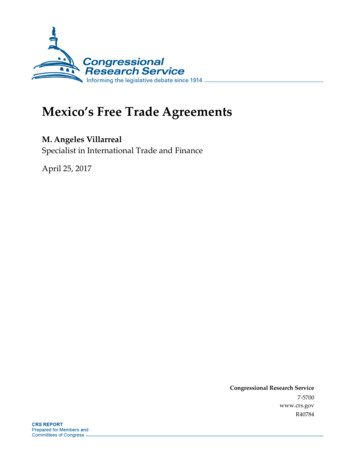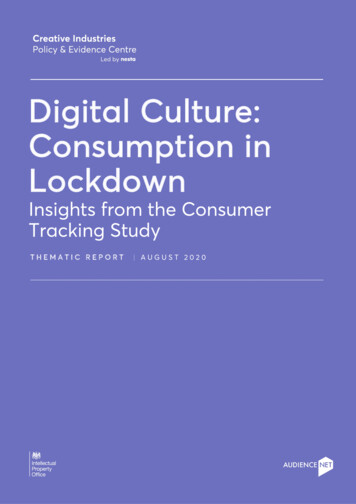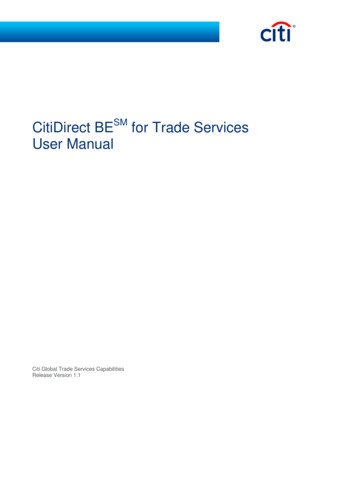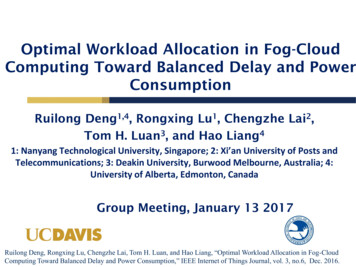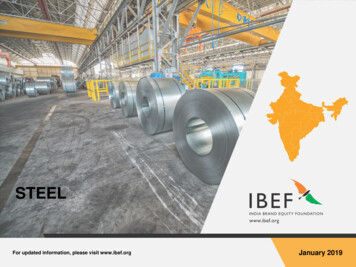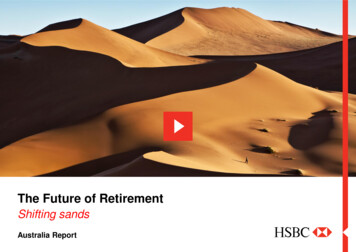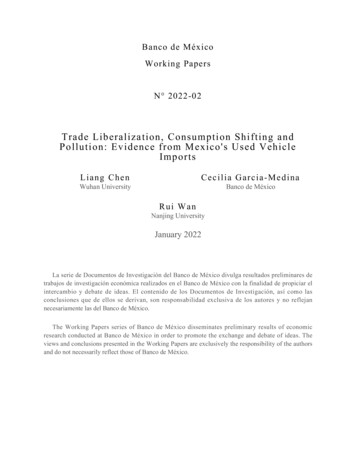
Transcription
Banco de MéxicoWorking PapersN 2022-02Trade Liberalization, Consumption Shifting andPollution: Evidence from Mexico's Used VehicleImportsLiang ChenCecilia Garcia-MedinaWuhan UniversityBanco de MéxicoRui WanNanjing UniversityJanuary 2022La serie de Documentos de Investigación del Banco de México divulga resultados preliminares detrabajos de investigación económica realizados en el Banco de México con la finalidad de propiciar elintercambio y debate de ideas. El contenido de los Documentos de Investigación, así como lasconclusiones que de ellos se derivan, son responsabilidad exclusiva de los autores y no reflejannecesariamente las del Banco de México.The Working Papers series of Banco de México disseminates preliminary results of economicresearch conducted at Banco de México in order to promote the exchange and debate of ideas. Theviews and conclusions presented in the Working Papers are exclusively the responsibility of the authorsand do not necessarily reflect those of Banco de México.
Documento de Investigación2022-02Working Paper2022-02Tr ade L i beral i zat i o n , Co n s u mp tio n Sh if tin g an dPolluti on: E vi dence from M ex ico ' s Us ed Veh icle I mp o r t s *Liang ChenyCecilia Garcia-MedinazWuhan UniversityBanco de MéxicoRui WanxNanjing UniversityAbstract: This paper develops a model of used vehicle trade between countries with differentenvironmental regulations regarding vehicle emissions. We show that the US, given its strictenvironmental regulations, has incentives to export used vehicles to Mexico, which impacts air pollutionemissions caused by automobile driving in Mexico. Using a unique database on vehicle registration inMexico and imports after the NAFTA enactment, we find that Mexico's used vehicle imports reducedaverage pollution emissions generated by vehicles, mainly due to the "technique effect" -differences inemissions of vehicles of comparable model and age between those that operate in the US before beingimported (that emit less pollutants) and those operating in Mexico.Keywords: Trade Liberalization, Used Vehicles, Pollution Emissions, Technique EffectJEL Classification: F13, L62, Q56, Q51Resumen: En este documento se desarrolla un modelo del comercio de vehículos usados entre paísescon diferentes regulaciones ambientales con respecto a las emisiones de autos. Se prueba que en EUA,dado las estrictas regulaciones ambientales, hay incentivos para exportar autos usados a México, lo cualafecta las emisiones de contaminación del aire por la movilidad vehicular en México. Utilizando unabase de datos del registro de vehículos en México y de importaciones posteriores a la firma de TLCAN,se encuentra que las importaciones de vehículos usados de México redujeron el promedio de emisionesde contaminantes vehiculares debido principalmente al "efecto técnico" -diferencia de emisiones devehículos de modelo y edad comparables entre los que circulan en EUA antes de ser importados (emitenmenos contaminantes) y los que circulan en México.Palabras Clave: Liberalización comercial, Autos usados, Emisiones de contaminantes, Efecto técnico*We are grateful to M. Scott Taylor, Carol McAusland, Pamela Campa, Eugene Choo, Atsuko Tanaka, PaulinaOliva, Trevor Tombe, Alejandrina Salcedo, René Livas, seminar participants and two anonymous referees forvaluable comments. We acknowledge support from the Humanities Research Council of Wuhan University, GrantNo. 413000048. This is a peer pre-reviewed version of the article: Chen, L, Garcia-Medina, BC, Wan, R. Tradeliberalization, consumption shifting and pollution: Evidence from Mexico's used vehicle imports. Rev Int Econ.2019; 27: 1591-1608, published in final form at DOI: 10.1111/roie.12436. The views expressed in this paper donot necessarily represent those of Banco de México. All errors are our own.y Department of Economics, School of Economics and Management. Email: liang.chen@whu.edu.cn.z Dirección General de Investigación Económica. Email: cecilia.garcia@banxico.org.mx.x Department of International Economics & Trade, School of Economics. Email: wanrui@nju.edu.cn.
1. IntroductionAs different countries impose different quality standards on public goods like clean air,such asymmetries may lead to different economic and regulation settings. In particular, thelinkage between the environment and trade is mainly focused on pollution generated fromproduction, particularly in the manufacturing sector.1 However, pollution generated from theconsumption side has been less studied, even though it is a significant contributor to globalpollution. A good example of consumption-generated pollution is vehicle driving, whichaccounts for a large fraction of air pollution emissions. 2 Moreover, the global trade invehicles is large, a significant fraction of which involves used vehicles. For example, Japanexported nearly 4 million vehicles to the world in 2015, 32% of which were used vehicles,while the United States exported 2.4 million vehicles to other countries in 2015, 22% ofwhich were used vehicles. 3 Therefore, in this article, we are interested in examining theeffects of trade in used vehicles on pollution emissions generated by vehicle driving.First, we develop a theoretical model of trade between two countries, the North and theSouth, differing in their environmental regulations on emissions, following Clerides andHadjiyiannis (2008). Vehicles are assumed to exist for three periods in which they can be:new, used, or clunkers. The North has a monopoly on producing new vehicles and sellingthem in both countries. Used vehicles and clunkers can be sold in perfect second-handmarkets without transaction costs. Consumers purchase at most one vehicle in each period,and consumers’ preferences for a vehicle’s quality are uniformly distributed in both the Northand South to generate smooth aggregate demand. To simplify the dynamics, we solve the1See Cherniwchan et al. (2017) for a recent survey on trade and the environment.Vehicle driving alone accounts for 53.6% of total carbon monoxide (CO) emissions, 57.7% of total nitrogenoxide (NOx) emissions, 23.4% of total emissions of volatile organic compounds (VOC), and 8.1% of totalemissions of particulates in the United States in 2014. In the Mexico City Metropolitan Area, all types of drivingvehicles accounted for 99% of CO emissions, 95% NOx, 44% of VOC, and 59% greenhouse gases of totalemissions in 2012.3In 2015, the portion of used vehicles that were exported as a percentage of total vehicle registration was 2.2%for Japan and 0.45% for the United States. Data for Japan were calculated by the authors based on TradeStatistics from Japan’s Ministry of Finance. Data for the United States were calculated by the authors based onthe United States International Trade Commission (USITC) Interactive Tariff and Trade DataWeb, using thecommodity code HTS-8703: Motor vehicles and other motor vehicles designed to transport people.21
model in stationary equilibrium in which the monopolist chooses a constant price path forthe new vehicles in each period.Within this context, we examine the effects of trade in used vehicles by comparing theequilibrium outcomes in three trade regimes: (1) no used vehicles are allowed to be traded(“Autarky” regime); (2) only used vehicles are allowed be traded (“UC” regime); and (3)both used vehicles and clunkers are allowed to be traded (“UCC” regime). We find that, inautarky, the North, the country with stricter emissions regulations, has a comparativeadvantage in used vehicles and clunkers which creates a motive for trading in used vehiclesthat is not exploited before trade liberalization. As a result, the North will export usedvehicles and/or clunkers to the South in UC and/or UCC regimes when trade in used vehiclesis open between the two countries, which shifts some of the consumption of new vehicles toolder used vehicles in the South. The consumption shifting changes the size and compositionof the new vehicles, used vehicles, and clunkers on the road in the South. These results implythat trade in used vehicles affects pollution emissions generated from vehicle driving in theSouth through three potential channels: scale effect, composition effect, and technique effect.We then focus our analysis on empirically quantifying the effects of trade in usedvehicles on pollution emissions. In particular, we examine used vehicle trade betweenMexico and the United States after NAFTA, which is perhaps the best-documented exampleof North-South trade in used vehicles. Although NAFTA came into effect in 1994, Mexicowas allowed to restrict its used vehicle imports until January 1, 2019. Imports of used vehiclesinto Mexico were strictly prohibited before 2005. After 2005, there were restrictions on theage of used vehicles allowed for import into Mexico, and these restrictions were graduallyrelaxed until 2019. We collect a unique dataset on used vehicle imports, new vehicle sales,vehicle registration by state and age in Mexico from 1995 to 2012 for implementing ourempirical analysis.Using the data, we first run regressions to investigate the effects of used vehicle importson vehicle fleet size and composition in Mexico. Our estimation results demonstrate thatwhen moving from the Autarky to the UC regime between 2005 and 2008 in Mexico (when2
only vehicles between 10 and 15 years old were allowed to be imported), imports of usedvehicles decreased new vehicle sales, conversely, when moving from the UC regime to theUCC regime from 2009 to 2012 (when restrictions on the age of used vehicles allowed forimport were gradually relaxed beyond 10 to 15 years old), imports of used vehicles increasednew vehicles sales. The regressions on the quantities of registered vehicles in the full samplefor vehicles of all age ranges and subsamples for vehicles of different ages indicate that usedvehicle imports in Mexico slightly increased the total fleet size of registered vehicles.Meanwhile, the estimated effects of used vehicle imports differ across subsamples forvehicles of different age ranges. These results suggest that used vehicle imports in Mexicoaffect the fraction of registered vehicles belonging to different age ranges, which suggests acomposition effect.Finally, we use our estimates to analyze the effects of used vehicle imports on pollutionemissions generated by vehicle driving in Mexico. We focus our study on four major airpollutants: methane (CH4), carbon monoxide (CO), oxides of nitrogen (NOx) and volatileorganic compound (VOC). Our results demonstrate that although used vehicle importsincrease the total number of used vehicles registered, they lowered pollution emissions perauto average by approximately 0.27%-14.68% in Mexico from 2005 to 2012, depending onthe pollutants considered. We further decompose the total effects into scale, composition andtechnique effects. The decomposition of total emissions shows that the negative effect ordrop in average emissions is explained by what we called the technique effect, created by thedifferences in emissions of vehicles of comparable model and age between those thatoriginally operate in the United States before being imported and those vehicles in Mexico.More specifically, the scale effect (change in the total number of vehicles) increasedemissions by 46.91%-54.13%, and the composition effect (change in proportions by age)increased the emissions by 2.18%-3.60%, while the technique effect decreased pollutionemissions by 50.34%-72.42%, depending on the pollutants considered.This paper contributes to a large body of literature examining the environmentalconsequences of trade liberalization. The argument made most frequently in the literature isthe pollution haven hypothesis (PHH) proposed by Grossman and Krueger (1993) and later3
formalized by Copeland and Taylor (1994). The debate on PHH has been largely settled byempirical work demonstrating that trade liberalization appears to have a small impact onproduction-generated pollution. For example, Antweiler et al. (2001) show that thecomposition effects of trade have only minor environmental consequences. Similarly,Levinson (2009) demonstrates that shifting polluting industries overseas has contributed atmost 10% to the overall cleanup of US manufacturing. Even though there is some work onthe consumption-generated pollution of trade liberalization,4 there has been little empiricalanalysis of the topic.5This paper also draws on the empirical literature on the effects of policy changes onvehicle emissions. Currently this empirical literature is very small.6 Oliva (2015) finds thatthe effectiveness of compulsory vehicle emission inspections on vehicle emissions iscompromised by corruption in Mexico City. The most closely related empirical paper isDavis and Kahn (2010) who also empirically study the environmental consequences ofexporting used vehicles from the United States to Mexico in 2005-2008. They find that tradedecreased average emission levels in the United States and increased average emission levelsin Mexico for carbon dioxide by focusing on only scale and composition effects. In contrast,following the guidance of our theoretical model, we calculate the effects of used vehicle tradeon pollution emissions generated from registered vehicles in Mexico by considering threeeffects: scale, composition, and technique effects. We argue that the overlooked techniqueeffect is significantly large relative to the scale and composition effects.The organization of the paper is as follows. In section 2, we present a theoretical modelto analyze the Autarky equilibrium, explore countries’ incentive to trade, and examine howtrade affects vehicle consumption under both UC and UCC regimes. The empirical analysisis developed in Section 3, in which we quantify the effects of used vehicle imports on vehicle4Copeland and Taylor (1995) first develop a theory to demonstrate how differences in environmental regulationfor consumption-based pollution altered predictions from PHH, which is extended by McAusland (2008).Theoretical research on trade liberation and consumption-generated pollution also includes Hu and McKitrick(2016), Fujiwara (2010), and Kellenberg (2010).5To our knowledge, the only exception is Davis and Kahn (2010).6This is mainly limited by the lack of available data, as “high quality measures of emissions from consumptionrarely exist, making empirical work difficult” (Holladay, 2008).4
consumption in Mexico and the related effects on pollution emissions generated by vehicledriving. Section 4 offers some concluding remarks. The appendix includes all the proof andtables.2. A Model of Trade in Used VehiclesOur model extends the durable goods model featuring quality certification developed byClerides and Hadjiyiannis (2008) by allowing vehicles to exist for three periods. We use thismodel to analyze how trade in used vehicles under different regimes affects the fleet size andcomposition of vehicles and the channels through which trade in used vehicles affectspollution emissions.2.1Model SetupWe consider any vehicle in use for all three of the following defined periods. A vehicleis considered to be “new” in period one of its life and it provides a predetermined level ofquality denoted by 𝑠. In period two of its life, the vehicle becomes “used” and its qualitydrops to 𝑘𝑢 𝑠, with 𝑘𝑢 [0,1]. In period three of its life, it becomes a “clunker” and its qualitydrops to 𝑘𝑐 𝑠, with 𝑘𝑐 [0,1] and 𝑘𝑐 𝑘𝑢 . At the end of period three, the vehicle is scrappedwithout quality. We hereafter use subscript “ 𝑛 ” to denote variables for new vehicles,subscript “𝑢” for used vehicles, and subscript “𝑐” for clunkers.New vehicles are produced by an infinitely lived monopolist, who produces vehicleswithout capacity constraints at a constant marginal cost of 𝑀. The monopolist chooses theprice of new vehicles at the beginning of each period to maximize profit. To simplify theanalysis, we follow Clerides and Hadjiyiannis (2008) by focusing on a stationary equilibriumin which the monopolist chooses a constant price path for new vehicles in every period; thatis, there is only one price 𝑝𝑛 for new vehicles in all periods. This implies that the marketoutcome will be identical in every period such that the prices of new and used vehicles, andclunkers are constant in every period, 𝑝𝑛,𝑡 𝑝𝑛 , 𝑝𝑢,𝑡 𝑝𝑢 , 𝑝𝑐,𝑡 𝑝𝑐 for all 𝑡, and thenmarket demand for new vehicles is also constant at every period, 𝑄𝑛,𝑡 𝑄𝑛 for all 𝑡.5
Used vehicles and clunkers are sold on the second-hand market without market frictionsand transaction costs. Therefore, the number of used vehicles in each period is equal to thenumber of new vehicles in the previous period and, similarly, the number of clunkers in eachperiod is equal to the number of used vehicles on the market in the previous period, 𝑄𝑛,𝑡 𝑄𝑢,𝑡 1 𝑄𝑐,𝑡 2 . In stationary equilibrium, the number of new vehicles will be equal to thatof used vehicles and clunkers for all periods, 𝑄𝑛 𝑄𝑢 𝑄𝑐 . To be sold, used vehicles andclunkers must pass a vehicle emission inspection, such as the emission inspection andmaintenance (𝐼/𝑀) program in the United States.7 To pass inspection, a used vehicle and aclunker incur costs 𝑇𝑢 and 𝑇𝑐 to the owner of the vehicle. We assume that 𝑇𝑢 𝑇𝑐 , as it ismore costly to maintain a clunker to pass inspection than a used vehicle.On the demand side, there is a constant density Φ of infinitely lived consumersdemanding vehicles. All consumers are differentiated only in their willingness to pay for thequality of vehicles, 𝑣, and identical in all other aspects. We assume that 𝑣 is uniformlydistributed over the interval [𝑣, 𝑣] with density 𝑓(𝑣) 1/(𝑣 𝑣). At the beginning of eachperiod, each consumer receives the same income flow of 𝑦, which will be allocated betweena composite numeraire good and a vehicle. The assumption that used vehicles and clunkerscan be sold without transaction costs in the second-hand market implies that owning a vehicleis equivalent to owning cash equivalent to the vehicle’s value. Therefore, owning or notowning a vehicle does not affect consumers’ purchase decisions.The utility consumers derive from purchasing a new vehicle, used vehicle, clunker, andno vehicle in each period is then given by 𝑈𝑛 𝑦 (𝑝𝑛 𝛿𝑝𝑢 ) 𝑣𝑠 , 𝑈𝑢 𝑦 (𝑝𝑢 𝑇𝑢 𝛿𝑝𝑐 ) 𝑣𝑘𝑢 𝑠 , 𝑈𝑐 𝑦 (𝑝𝑐 𝑇𝑐 ) 𝑣𝑘𝑐 𝑠 , and 𝑈0 𝑦, respectively,where the second term in 𝑈𝑛 , 𝑈𝑢 , and 𝑈𝑐 is the cost to own a vehicle, or the differencebetween purchasing price and resale price plus the inspection cost for reselling. Comparingthe above four utility functions determines the demand functions for new vehicles, usedvehicles, and clunkers, which are denoted by 𝑄𝑛 (𝑝𝑛 , 𝑝𝑢 , 𝑝𝑐 ) , 𝑄𝑢 (𝑝𝑛 , 𝑝𝑢 , 𝑝𝑐 ) andAccording to the United States Environmental Protection Agency (EPA), “Vehicle inspection andmaintenance programs (I/M) help improve air quality by identifying high-emitting vehicles in need of repairand causing them to be fixed as a prerequisite to vehicle registration within a given non-attainment area.”76
𝑄𝑐 (𝑝𝑛 , 𝑝𝑢 , 𝑝𝑐 ), respectively. The explicit forms for these functions and their derivations areprovided in the proof of Proposition 1 in Appendix A.2.2Autarky EquilibriumWe first solve for equilibrium prices and demand for new vehicles, used vehicles andclunkers in autarky. In this context, an economy of autarky refers to the conditions in whichthe international trade in used vehicles is closed. The equilibrium prices emerge from themonopolist’s profit maximization condition for new vehicles and market clearing conditionsfor used vehicles and clunkers in second-hand markets. The first order condition of themonopolist’s profit maximization problem is derived as81𝑝𝑛 2 [𝑣𝑠(1 𝑘𝑢 ) (1 𝛿)𝑝𝑢 𝛿𝑝𝑐 𝑇𝑢 𝑀].(1)Market clearing conditions for used vehicles and clunkers imply that the supply of usedvehicles and clunkers is equal to the demand for them in the second-hand market,𝑄𝑛 (𝑝𝑛 , 𝑝𝑢 , 𝑝𝑐 ) 𝑄𝑢 (𝑝𝑛 , 𝑝𝑢 , 𝑝𝑐 ),(2)𝑄𝑢 (𝑝𝑛 , 𝑝𝑢 , 𝑝𝑐 ) 𝑄𝑐 (𝑝𝑛 , 𝑝𝑢 , 𝑝𝑐 ).(3)Equations (1)-(3) generate three equations to solve for three equilibrium (vehicle) prices𝑝𝑛 , 𝑝𝑢 and 𝑝𝑐 . Demand for the three types of vehicles can be derived by using the demandfunctions accordingly. Proposition 1 summarizes the effects of the emission inspection onthese equilibrium prices and demand for new vehicles, used vehicles and clunkers.Proposition 1. Emission inspection in an autarky economy in used vehicles and clunkersleads to: (i) decreases in all prices of new vehicles, used vehicles, and clunkers; and (ii)decreases in the quantities of new vehicles, used vehicles, and clunkers sold in the market. Proof: See Appendix A.The reason that the emission inspection decreases the prices and quantities of usedvehicles and clunkers is intuitive. The emission inspection increases the cost of owning these8See Appendix for derivation.7
vehicles, which drives down the demand and their prices. It seems counterintuitive that theinspection decreases the price and quantity of new vehicles. On the one side, the decrease indemand for used vehicles and clunkers might increase the demand for new vehicles becausethey are substitute. On the other side, the introduction of the emission inspection drives theprices of used vehicles and clunkers down, which decreases the cash value of owning a newvehicle. This income effect decreases the price and quantity of new vehicles and is largerthan the substitution effect. As a result, the inspection will also decrease the price andquantity for new vehicles.2.3Effects of Trade in Used Vehicles and/or ClunkersWe now analyze how trade in used vehicles and/or clunkers affects market equilibriumdemand for the three types of vehicles. To do so, we introduce a second country in whichused vehicles and clunkers do not need to undergo an emission inspection. We call theoriginal country the “North” and the second country the “South”, and the variables relatingto corresponding countries will be denoted using 𝑁 and 𝑆, respectively. We also assume thatthe South does not produce new vehicles, such that the monopolist in the North produces andsells new vehicles in both countries. The two countries are identical in every other aspect.When the two countries differ only in emission inspection policies, the North will have acomparative advantage in used vehicles and clunkers, which creates the motive for tradebetween the two countries. Proposition 1 implies that the emission inspection reduces theprice of older vehicles more than that of newer vehicles in Autarky. As a result, the relativeprices of newer vehicles compared to older vehicles in the North with the emission inspectionwill be higher than those in the South without the emission inspection in autarky. Thefollowing lemma confirms our intuition formally.Lemma 1. The North has higher prices for new vehicles relative to used vehicles than theSouth in autarky; The North also has higher prices for used vehicles relative to clunkers thanthe South in autarky. That is,8
𝑝𝑛𝑁 𝑝𝑛𝑆 ,𝑝𝑢𝑁 𝑝𝑢𝑆𝑝𝑢𝑁 𝑝𝑢𝑆 .𝑝𝑐𝑁 𝑝𝑐𝑆(4) Proof: See Appendix A.The inequalities in (4) imply that it is relatively cheaper to own an older vehicle than toown a relatively newer vehicle in the North. Presumably, if older vehicles are relativelydirtier (emit more) than newer vehicles, Lemma 1 shows that the North with its stringentenvironmental regulations has a comparative advantage in relatively older and dirtiervehicles when pollution is generated by consumption, or vehicle driving. This differs fromthe main result in the pollution haven hypothesis (PHH) literature, which indicates that thecountry with stringent environmental regulations has a comparative advantage in cleanergoods when pollution is generated by production. Therefore, the difference in environmentalregulations between countries in our context creates a motive for trade.2.3.1 Trade in Used Vehicles (UC Regime)In this section, we analyze the effects of trade in which only used vehicles can be traded(the UC regime) on market equilibrium demands for the three types of vehicles. 9 We firstsolve the market equilibrium prices by using the monopolist’s profit maximization conditionfor new vehicles and market clearing conditions for used vehicles and clunkers in the secondhand markets in both countries. The first order condition of the monopolist’s profit on newvehicle prices in both countries is derived as,𝑗1𝑗𝑗𝑝𝑛 2 [𝑣𝑠(1 𝑗 𝑘𝑢 ) (1 𝛿)𝑝𝑢 𝛿𝑝𝑐 𝑗 𝑇𝑢 𝑀], 𝑗 {𝑁, 𝑆},(5)where 𝑗 1 for the North 𝑗 𝑁 and 𝑗 0 for the South 𝑗 𝑆. In this UC regime inwhich only used vehicles can be traded, the market clearing condition for used vehiclesrequires that the global quantity of new vehicles is equal to the global quantity of used9The UC regime operates in some countries to avoid importing clunkers that will become the automotive wastein a short period. For instance, Cyprus prohibited imports of vehicles more than two years old before 1993. TheMexican government allowed imports of vehicles only between 10 and 15 years old, from 2005 to 2008.9
vehicles, 𝑄𝑛𝑁 𝑄𝑛𝑆 𝑄𝑢𝑁 𝑄𝑢𝑆 , and the market clearing condition for clunkers requires𝑗that the quantity of used vehicles is equal to the quantity of clunkers in both countries, 𝑄𝑢 𝑗𝑄𝑐 , 𝑗 {𝑁, 𝑆}. Finally, free trade in used vehicles drives their prices to be equal across thetwo countries in equilibrium, which gives, 𝑝𝑢𝑁 𝑝𝑢𝑆 .The above market equilibrium conditions provide us with six equations to solve sixprices for new vehicles, used vehicles and clunkers in market equilibrium for both countries.The market equilibrium demands can then be derived by substituting these equilibrium pricesinto the demand functions. We then compare the market equilibrium demands in autarky withthose in the UC regime to investigate the effects of trade in used vehicles on demand for thethree types of vehicles. Proposition 2 summarizes the main results.Proposition 2. Moving from autarky to a UC regime leads to (i) an increase in the quantityof new vehicles in the North; (ii) a decrease in the quantities of both used vehicles andclunkers in the North; (iii) a decrease in the quantity of new vehicles in the South; and (iv)an increase in the quantities of both used vehicles and clunkers in the South. Proof: See Appendix A.The logic underlying these results is that free trade in used vehicles changes the cost gapbetween different types of vehicles. We focus on illustrating the results on the North. First,free trade in used vehicles reduces the price of new vehicles and increases the price of usedvehicles, which narrows the difference in cost between owning new vehicles and usedvehicles in the North. This induces some consumers to purchase new vehicles instead of usedones.Second, free trade also increases the prices of clunkers, which also narrows thedifference in cost between owning used vehicles and clunkers in the North, and shifting someconsumers from purchasing clunkers to purchasing used vehicles or not purchasing a vehicle.The consumers shifting from used vehicles to new vehicles are more than those switchingfrom clunkers to used vehicles, as some consumers buying clunkers in autarky shift to not10
buying a vehicle. Therefore, the free trade in the UC regime increases the quantity of newvehicles and decreases the quantities of used vehicles and clunkers in the North. The effectson the quantities of the three types of vehicles in the South are the opposite of the effectsseen in the North.2.3.1 Trade in Both Used Vehicles and Clunkers (UCC Regime)Finally, we investigate the effects of trade in the regime where both used vehicles andclunkers can be traded (the UCC regime) on market equilibrium demands for the three typesof vehicles. As in the UC regime, market equilibrium prices are solved by using themonopolist’s profit maximization conditions and market clearing conditions for usedvehicles and clunkers in second-hand markets. The first order conditions from themonopolist’s profit maximization problem are given by,𝑗1𝑗𝑗𝑝𝑛 2 [𝑣𝑠(1 𝑗 𝑘𝑢 ) (1 𝛿)𝑝𝑢 𝛿𝑝𝑐 𝑗 𝑇𝑢 𝑀], 𝑗 {𝑁, 𝑆},(6)In the UCC regime, market conditions for used vehicles and clunkers in the world marketrequire that the global quantity of new vehicles be equal to the global quantity of usedvehicles, which is also equal to the global quantity of clunkers in equilibrium, 𝑄𝑛𝑁 𝑄𝑛𝑆 𝑄𝑢𝑁 𝑄𝑢𝑆 𝑄𝑐𝑁 𝑄𝑐𝑆 . Free trade in both used vehicles and clunkers will also equalize theirprices across the two countries in equilibrium, which gives 𝑝𝑢𝑁 𝑝𝑢𝑆 , 𝑝𝑐𝑁 𝑝𝑐𝑆 .The above conditions generate six equations to solve six market equilibrium prices forthe three types of vehicles in both the North and the South. The market equilibrium demandsfor the three types of vehicles can be solved by substituting these prices into the demandfunctions. Proposition 3 summarizes the results regarding the effects of moving from the UCregime to the UCC regime in both countries.Proposition 3. Moving from the UC regime to the UCC regime leads to (i) a decrease in thequantities of new vehicles and clunkers in the North;(ii) an increase in the quantity of used11
vehicles in the North;(iii) an increase in the quantities of new vehicles and clunkers in theSouth; and (v) a decrease in the quantity of used vehicles in the South. Proof: See Appendix A.We focus on explaining the logic behind the results in the North. Moving from the UCregime to the UCC regime increases the cost gap between owning new vehicles and owningused vehicles, which shifts some consumers from purchasing new vehicles to purchasingused vehicles in the North. Moving from the UC regime to the UCC regime narrows the costgap between owning used vehicles and owning clunkers, which shifts some consumers frompurchasing clunkers to purchasing used vehicles or not buying a vehicle. Therefore, free tradein both used vehicles and clunkers increases the quantity of used vehicles, but decreases thequantities of new vehicles and clunkers. The effec
*We are grateful to M. Scott Taylor, Carol McAusland, Pamela Campa, Eugene Choo, Atsuko Tanaka, Paulina . advantage in used vehicles and clunkers which creates a motive for trading in used vehicles that is not exploited before trade liberalization. As a result, the North will export used . while the
